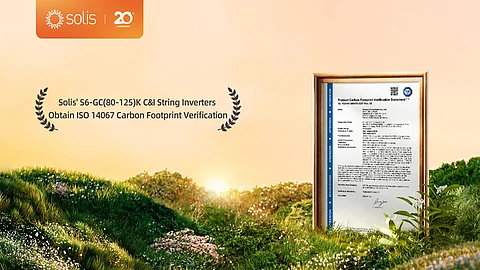

Solar inverter manufacturer Ginlong (Solis) Technologies has received ISO 14067:2018 Product Carbon Footprint verification from TÜV SÜD for its S6-GC(80-125)K commercial and industrial inverter series. The certification evaluates greenhouse gas emissions across a product’s entire lifecycle.
According to the company, this product is designed for flexible and reliable grid integration, with features such as master-slave export power control, 3-phase unbalanced output, dual RS485 ports for third-party compatibility, and AI-based arc fault protection. In terms of safety, the inverter features real-time PV grounding detection, coordinated rapid shutdown, and integrated meteorological sensors for intelligent monitoring.
On the financial side, Solis’ revenues increased 13.09% year-on-year in H1 2025 (see China Solar PV News Snippets).
Chinese electricity developer China Resources Power (CR Power) has announced the bid results for the second batch of its solar module centralized procurement in 2025, totaling 3 GW of n-type TOPCon bifacial dual-glass modules. The procurement is divided into 3 packages:
Package 1 (module power ≥620 Wp; size 2,382 × 1,134 × 30 m): 22 companies participated under this category for 1.5 GW capacity. Bids ranged from RMB 0.677/W ($0.094) to RMB 0.776/W ($0.108/W), and an average of RMB 0.729/W ($0.102/W).
Package 2 (≥710 Wp; 2,384 × 1,303 × 33 mm): This category saw participation from 22 companies, for a total capacity of 1.2 GW. Bids ranged from RMB 0.690 ($0.096) to RMB 0.752/W ($0.105), and an average of RMB 0.729/W ($0.102).
Package 3 (≥710 W; 2,384 × 1,303 × 35 mm): 19 companies participated for 300 MW capacity, with bids ranging from RMB 0.673/W ($0.094) to RMB 0.744/W ($0.104), and an average of RMB 0.718/W ($0.100).
Chinese perovskite manufacturer Jinghao New Energy announced that the 30 × 30 cm large-area ultrathin flexible perovskite solar cell, developed in-house, has achieved a certified power conversion efficiency of 19.10%, as verified by the National Institute of Metrology of China (NIM). The company stated that this result sets a new record for cells of this size. It has also bettered its own achievement of 18.06% efficiency on the same cell size in May 2025.
Heterojunction (HJT) solar module manufacturer SoleFiori is advancing its HJT solar cell and module manufacturing facility. In July 2024, the company signed an agreement with the government of Qidong City, Jiangsu Province, committing a total investment of RMB 4 billion ($557 million) to build a new 4 GW HJT solar cell and 6 GW HJT module plant (see China Solar PV News Snippets).
The company recently submitted the environmental impact assessment (EIA) report for the first phase of the project to the local government. According to the report, Phase I will involve a total investment of RMB 1 billion ($139 million) to establish a manufacturing facility with an annual capacity of 2 GW of 210 x 105 mm HJT bifacial dual-glass modules.
According to data released by China’s National Bureau of Statistics (NBS), large-scale industrial enterprises, defined as those with annual main business revenue of RMB 20 million ($2.79 million) or more, produced 66.38 GW of solar cells in July 2025, up 16% year-over-year (YoY). From January to July, total solar cell output reached 473.96 GW, representing a YoY increase of 19.6%.
NBS also disclosed power generation data within the same report. In 7M 2025, large-scale enterprises generated 5,470.3 TWh, up 1.3% YoY. Solar power generation accounted for 326.8 TWh of the total, up 22.7% YoY, while wind power generation reached 629.1 TWh, up 10.4%.
